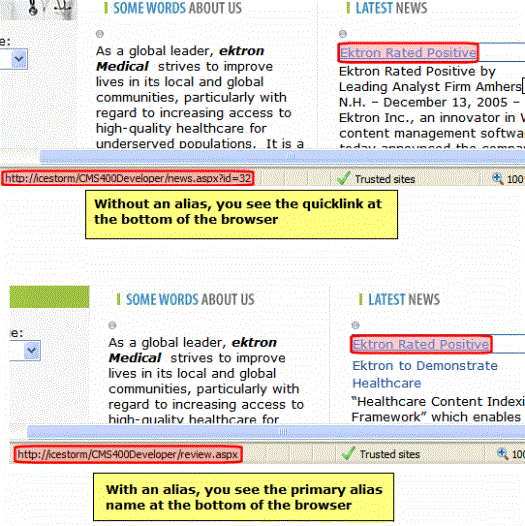
Types of URL Aliasing
The types of URL aliasing are described below.
Automatic Aliasing - Can automatically change the page name format of a group of content blocks. You determine the group by selecting a taxonomy or a top-level Ektron CMS400.NET folder.
For example, you might choose a folder and alias its content using the content title followed by slash (/). So, while the original URL might be www.example.com/Human_resources/Postings/hr.aspx?id=8745, the aliased one might be www.example.com/jobs/.
For more information, see Automatic URL Aliasing.
Manual Aliasing - You can manually alias any content block using whatever unique name you wish. For example, you can alias your technical support page as www.example.com/help.htm, even though its real name is www.example.com/help.aspx?id=27.
You can assign several manual aliases to content then decide which one is the primary. For more information, see Manual Aliasing.
If both alias types are provided for a content item, a user can enter any alias into the browser address field to access that content. If someone hovers the cursor over (or clicks) a link to aliased content, the primary manual alias appears.
Regex-based Aliasing - RegEx expressions allow site visitors to enter a human-readable URL into the browser address field and transform that entry into the query string component of an Ektron CMS400.NET page. The benefit is that the site visitor can “guess” other pages based on an easily recognizable pattern. For example, a RegEx expression aliases blogs.aspx?blogmonth=3&blogyear=2006&blogid=41 as blogs/2006/03/41. From that, a site visitor can infer that he can enter blogs/2006/03/40 to see the previous post, enter blogs/2006/03 to see all March 2006 posts, etc. For more information, see Using RegEx Expressions.
Site Aliasing - If your site supports the multi-site feature, you can enter aliases for any site. For example, your company‘s name just changed from Bionics to NewGen. You could use the site aliasing feature to resolve the url www.bionics.com to www.newgen.com. For more information, see Site Aliasing.
Community Aliasing - You can create aliases that include a community user name or community group. This provides easy-to- use URL addresses for each person's profile or groups that others can visit. An example Community User Alias is: http://www.example.com/John. For more information, Community URL Aliasing.
Example of an Alias in the Browser



